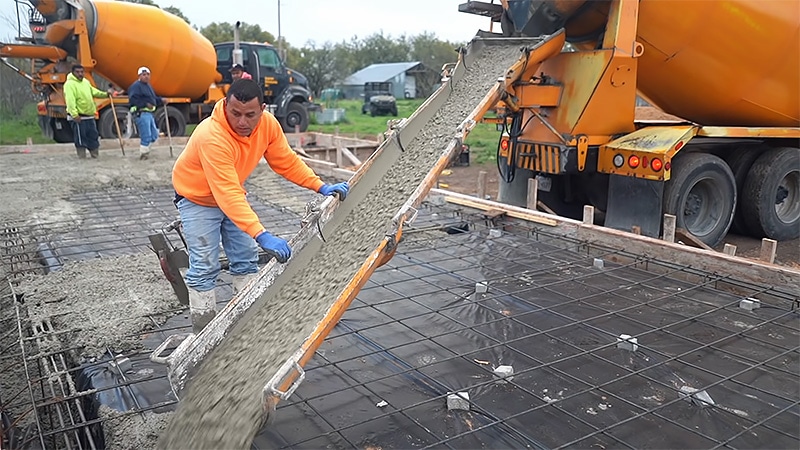
You may not find spray paint specifically designed for concrete, but you can definitely use spray paint on concrete.
Pretty much every outdoor-rated spray paint can be used on concrete floors or statues; it doesn't matter.
For best results, stick to acrylic paints that have an outdoor rating. Acrylic paints are chemical-based paints that have a lot of desirable qualities.
👉 Related reading: What Paint Sticks to Polyurethane?
First and foremost, acrylic paints adhere to lots of different surfaces. This is why you’ll notice many spray paints marketed for general outdoor use. These paints work well on metals, wood, wicker, plastic, and masonry.
The only surface that acrylic spray paint will have difficulty with previously painted surfaces with oil-based paints.
Another great thing about acrylic paint is that it has quite a lot of elastic capabilities. This means that it can expand and contract with the weather conditions. This is important because concrete, despite its dense appearance, does expand slightly when warm. Because the acrylic can match this movement, the paint is less likely to crack.
All-purpose exterior paint will usually suffice if you can’t find acrylic spray. Just make sure it is rated for outdoor use and that it is fully waterproof.
You can use a concrete stain spray if you don’t want to use spray. These are not designed to mimic the appearance of concrete. Instead, they aim to add color to otherwise dull, drab concrete flooring.
Concrete stain is harder to come by in spray paint form, but it's out there. Rustoleum, for example, has a few different stain sprays.
The stain is often sold as a liquid that can be sprayed onto concrete using a chemical sprayer.
👉 Related reading: Can I Add Sand To Floor Paint?
How Long Does Spray Paint Last on Concrete?
If applied properly, spray paint has a life span similar to other paints for several years. It depends on the kind of weather and uses the area is exposed to and also how well the paint was applied.
Let’s look at the applications first.
Before applying spray paint to concrete, you need to ensure it is clean, dry, and free from particulates. If you don’t thoroughly clean your concrete before painting, the spray paint won’t be able to adhere to the surface of the concrete. This is because it will end up sticking to the particulates hanging around on the surface.
A power washer is one of the best and easiest ways to clean up your concrete. If it’s filthy, like a garage floor, use some concrete cleaner too.
If the concrete has been previously painted, you must remove any loose or flaky paint. Again, this is to ensure the new paint goes smoothly and adheres to the concrete.
If you want the concrete to have a smooth and even surface, you should use a primer. This stuff fills pores and creates an even surface for the paint. If you don’t mind the porous look, then you can skip the primer step.
You can now apply the spray paint. It might help to do a base coat, especially if you haven’t used a primer in the color you will use for the rest of the wall or a neutral white color.
Make sure to let the paint dry between coats. This will help your paint job last longer as the paint creates cured and adhered layers. It is particularly important to let the base coat fully dry and cure, as this coat is the one that actually has to stick to the concrete.
Once you’ve finished, you can use clear enamel or gloss coating for a shiny look. If you don’t, then just leave it.
Following these steps, you can expect to see your paint last 3 – 5 years.
High-traffic areas like garage floors or driveways will not last quite as long. If they see lots of action, you can find yourself repainting after a year or so.
If you’re painting something that is going to spend a lot of time outdoors, like a wall or plant pot, make sure the paint is outdoor rated. This ensures that it is waterproof and has some level of UV protection.

Is There a Spray Paint that Looks Like Concrete?
Yes, there is!
There are lots of spray paints out there that are designed to look like concrete. In fact, you can get spray paints that mimic many different kinds of stone and building materials, including terracotta and brick.
There are two different ways of creating a concrete effect.
Some paints use mixed colors to create the depth and dimension of concrete. These paints often contain glitter-like particles that reflect light to create highlights and shadowed areas.
👉 Related reading: Alkyd Enamel: The Ultimate Guide
Other paints are called textured paints. These often have small sand or silicone particles inside the can. These particles are expelled with the paint, creating a bumpy, stone-like texture.
Textured paints don’t keep well as they habitually clog up the tubes and holes. If you will use this paint, it is best to use the whole can in one go.
The other thing you need to be aware of is the fact that you’ll need more texture than if you were using non-textured paint. Not only does the sand take up room in the can, reducing the space for paint, but it also doesn’t cover as well as paint.
Most people find that they need to buy double the number of textured spray paint cans compared to normal spray paint cans.
As with any other paint, if you’re using it on concrete that gets wet, make sure it’s waterproof and suitable for outdoor use.
If you use indoor paint on external concrete, you’ll find that it washes with the first decent rainstorm. This is obviously not ideal, so try to get it right the first time around.
Continue reading:





